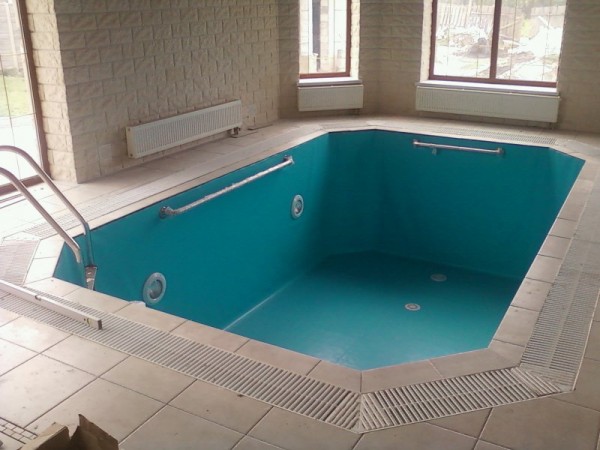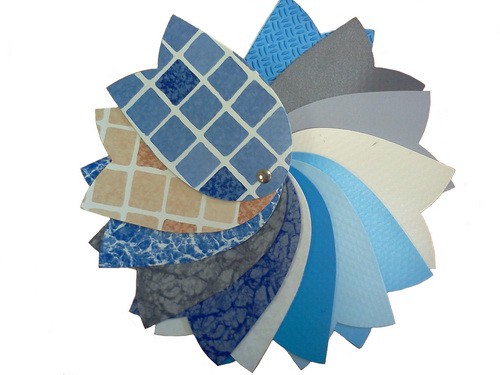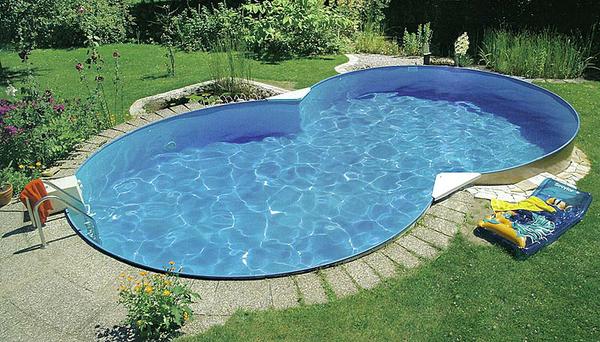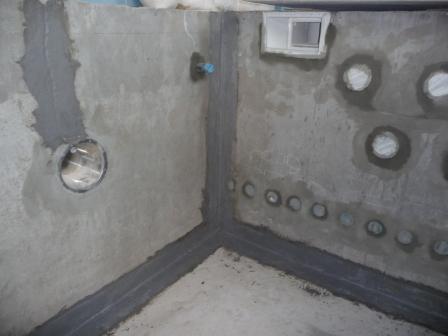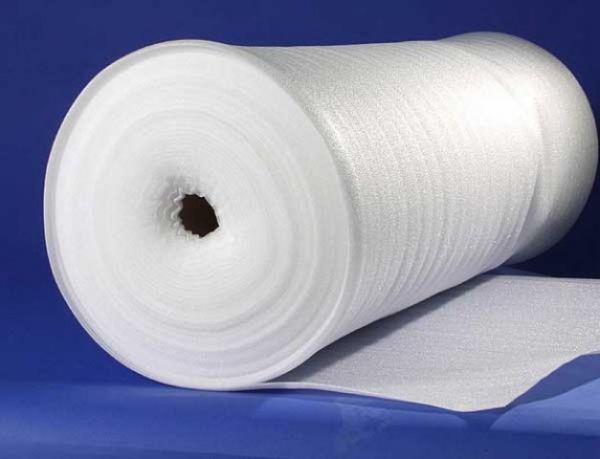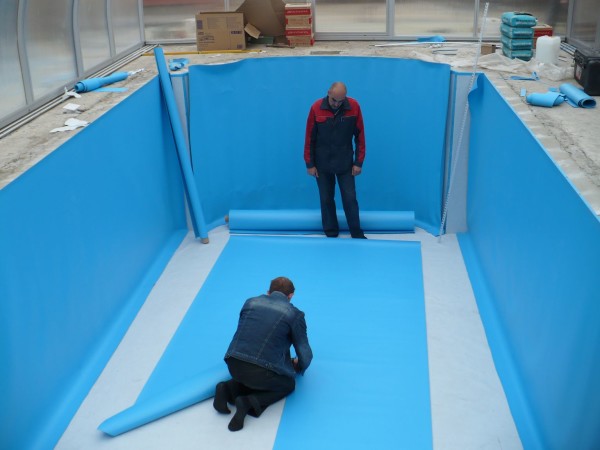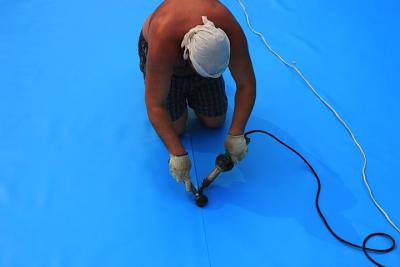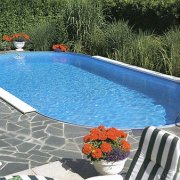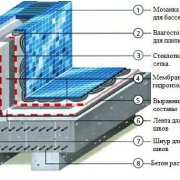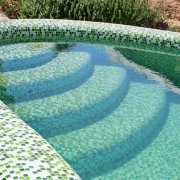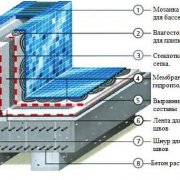Lining the pool with film: the nuances of technology
The pool is a rather complicated technical structure, requiring a competent approach to its construction. Do not build a capital pool with your own hands, it requires experienced specialists who can work with utilities and know the technology.
One of these technologies is the pool lining, with which we will introduce you in this article.
The content of the article
PVC films for the pool
It is not cheap to build a pool in the classic version, with ceramic tiles, especially if it has a large volume. The construction of such a structure, even of a small size, requires a lot of time - more than three calendar months.
So:
- Facing films for pools can reduce this period to one and a half months, and their price significantly reduces the cost of the facility. These criteria are often decisive when a client chooses a pool decoration method.
- By their decorative and operational properties, the films for pool lining are inferior, of course, to ceramic tiles or mosaics (seeMosaic pool decoration: fashion or style), but not everyone seeks to make an architectural masterpiece out of this structure. It is enough for many that the finish will be high-quality and reliable, without frills.
- Importantly, the PVC film for pool lining is not only a finishing material, but also waterproofing, moreover, it is very flexible and durable. The basis for the production of such films is plasticized polyvinyl chloride reinforced with a polystyrene mesh.
- This material in the production process is subjected to special impregnation, preventing the development of microorganisms on its surface.
For the pool, this is very important, it does not have to be cleaned often. So, there are pluses in this finish too. - PVC film is available for pool lining in rolls 1.6m wide. One roll is enough to cover forty squares of a concrete bowl.
Among the assortment of PVC coatings for pools, which you see on the photo above, there are smooth options, as well as films with a non-slip surface. - Corrugated film is used for facing the steps of stairs leading into the water, as well as for covering the bottom in the smallest areas of the pool. By the way, this finish is highly recommended for outdoor pools, since PVC is better than tiles, tolerates temperature extremes.
- The manufacturers of this material do everything to foil for swimming pools It was not only durable, but also aesthetically pleasing and varied.
- In addition to plain PVC films, options began to appear with drawings stylized as marble texture, ceramic tiles, and even mosaics. Naturally, such a coating is somewhat more expensive.
The service life of the film coating of the pool is about ten years. This is much smaller than that of ceramic tiles, and is the only drawback of this material.
On the other hand, the lining of PVC pools is fast, the film is easy to repair or replace, updating at the same time the appearance of the pool.
Preparatory work
In order for the lining to turn out to be of high quality, work should begin with the preparation of the base. The quality of further finishing will depend on how well it is performed.
So:
- It is important that on the surface of the pool bowl there are no sagging of the solution, or potholes. If the bowl is brick, it must first be plastered, and then sanded.
The concrete surface may have to be puttied.
- When performing alignment, special attention should be paid to corners and edges. In these places, the adhesion of the solution to the base should be as tight as possible.
- In the process of preparatory work, it is necessary to pay attention to all embedded parts to be installed flush with the surface, as well as equipped with sealing flanges. If it turns out that they are buried, it will be difficult to carry out installation of the coating.
- Flanges are usually made of plastic or stainless steel, and have a rubber gasket that is resistant to chlorine. These parts must ensure a tight connection with the embedded elements using a screw connection.
- PVC film for pool lining is now often used for the reconstruction of old structures, which already have waterproofing. In this case, the film is mounted directly on the ceramic tile.
The main thing is that she does not depart from the foundation anywhere. If necessary, unreliable elements of the old coating are dismantled, alignment is made, and then the film is mounted.
Film cladding
PVC film is fixed with a fixing strip. This is a two-meter metal tape 2 mm thick and not more than ten centimeters wide.
On the one hand, a polymer coating is applied to the tape, to which the film is welded:
- The mounting strip is mounted end-to-end to the surface of the walls, just below the pool edge, using dowels. The location of the mounting strips may vary, depending on the complexity of the configuration of the bowl.
- And it can be multi-level, have steep slopes and turns. In each case, experts make an individual decision.
If necessary, the tape is attached to the bottom, this will prevent the movement of bottom sheets and the formation of wrinkles on the film. - In some cases, corners are also used, for example, if there is a concrete staircase in the pool. They cover all the protruding faces of the steps, and allow you to fasten PVC segments with tension, reducing the number of points of attachment of the film to concrete.
- Before installing the film, a special geotextile substrate is laid on the bottom of the pool. Its main task is to protect the coating from abrasion, as a result of direct contact with concrete during operation.
- The substrate is clamped between the fixing strips and the base. If you are interested in this issue, you can watch the video.
Geotextile pieces fit end-to-end, without overlap, and discrepancies. In areas of the base having a complex configuration, the substrate is fixed with glue. - At the locations of embedded parts, in the sheets of geotextile, holes of the corresponding configuration are cut so that it does not interfere with the compression of the film by the flanges.
- In those areas where the film coating will be welded, self-adhesive foil is fixed over the substrate. It prevents the burning of geotextile sheets.
- It is necessary to approach the cutting of the canvas with utmost care in order to reduce the amount of waste. To do this, you need good scissors and the longest metal ruler.
- For work, you will need a coloring cord, a special hairdryer with a set of nozzles for welding polymer materials, a pinch roller for rolling seams, and a linoleum knife. To remove carbon deposits on the welding machine, a metal brush is used.
- Welding of PVC sheets is carried out by a jet of hot air supplied by a hairdryer. Its temperature is regulated, depending on many factors: mains voltage, air temperature indoors or outdoors, welding speed.
There are other nuances of using a hair dryer, as the operating instructions will tell you about them. - What matters is what the PVC sheet is welded to: on the same material or on the fastening strip. Installation of the film is carried out only at positive temperature. The warmer, the better the coating will be.
- First, the coating sheets are laid out, which will be mounted on the bottom. They are laid with an overlap of up to five centimeters, all over the bottom, with a slight indentation from the walls.
If the bottom has a complex configuration and slopes, the sheets are fixed so that during subsequent filling of the pool with water, they do not shift. - Best of all, spread the film, let it lie down. Before welding, the surface of the PVC must be free of dust and any contaminants.
Before welding the seam, the joints of the sheets are fixed by the tack method. - This is an incomplete heating and pressing of certain sections of the joints. Thus, the possibility of accidentally changing the initial position of the film, which may lead to the formation of folds, is prevented.
- After the device for coating the bottom of the pool is completed, proceed to hanging pieces of film on the walls. They are hung on a plumb line, with the same overlap of seams as at the bottom, and are welded to the fastening strips along the sides.
Note! For welding horizontal surfaces with vertical, as well as corner joints, the overlap between the sheets of the film is done more - up to 15 cm.
- Particular attention should be paid to the seams passing from the plane of the bottom to the plane of the walls. There are some nuances here, and the specialists who install the film know about them.
Last of all, welding is carried out in the inner corners of the pool, after which the quality of all the seams is checked. - If everything is normal, and there are no complaints about the quality of welding, the seams are treated with a special sealant. It comes complete with a film, and has the same color.
It is a liquid mass that hardens in the open air, but remains elastic after solidification. - This composition is designed to provide additional tightness of the seams. It is applied to the joints of the film using a special container, similar to a nipple.
On vertical joints, the sealant is applied from top to bottom. For its hardening, half an hour is enough, and you can fill the pool.
The first filling of the pool should be done with warm, but not hot water. First, it is filled with forty centimeters, which contributes to the good tension of the vertical film coating.
After that, you can make holes in it and install flanges on the embedded parts. When flanges and decorative elements are installed, the pool can be filled to the top.
